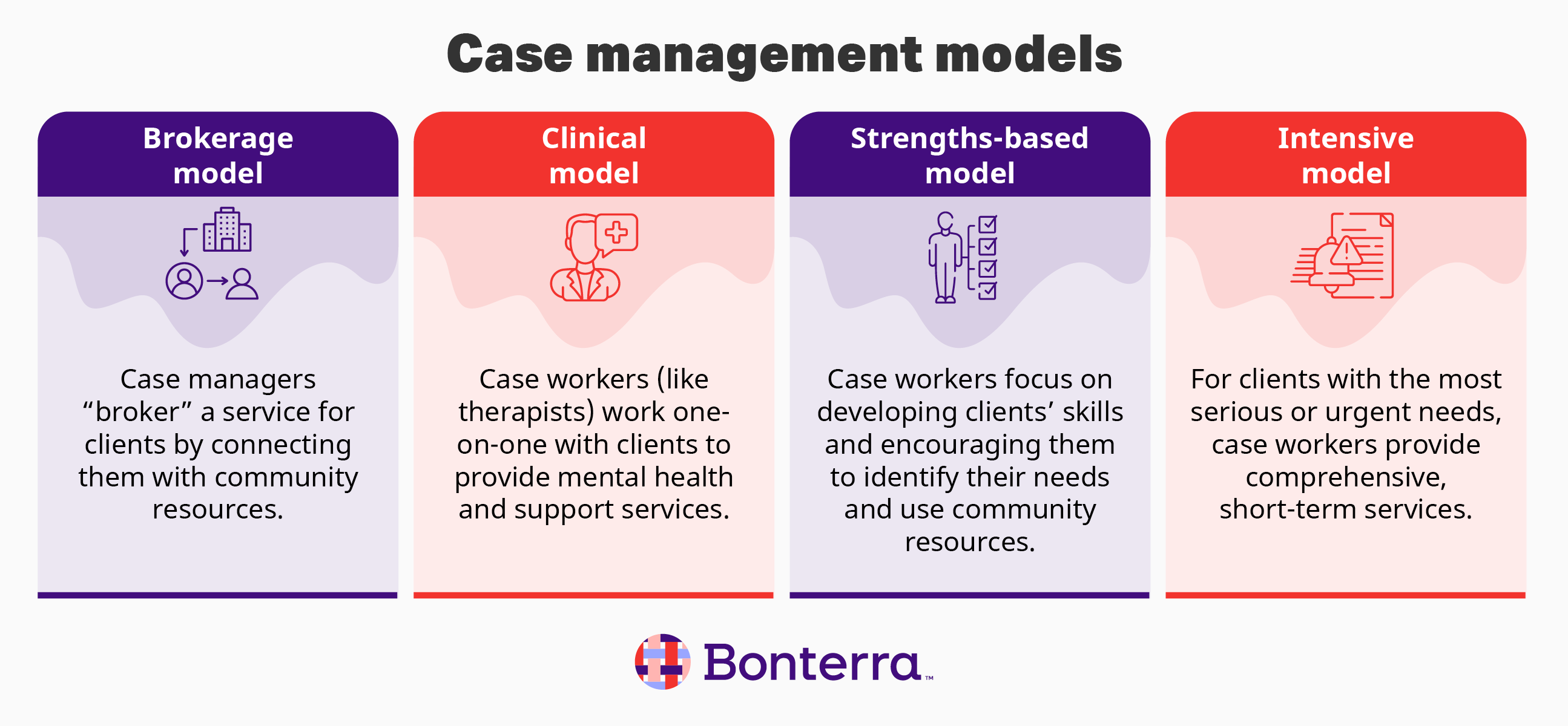Case management is a key component of many public sector, healthcare, and human services workers’ daily lives, but what exactly does it entail? What does the process look like, and why is it important for the parties involved?
This guide will answer all of these questions and more. We’ll use industry best practices to break down core principles and steps of the case management process for public agencies and nonprofit organizations. Plus, we’ll explore real-life examples of case workers using best-in-class tools to deliver quality, person-centered care.

 Let’s explore how each component can be incorporated into a unified case management system to collect data, track client success, foster organizational change, increase funding, and accelerate impact.
Let’s explore how each component can be incorporated into a unified case management system to collect data, track client success, foster organizational change, increase funding, and accelerate impact.

What is case management?
Case management is a collaborative process that assesses, plans, implements, and monitors the options and services required to meet your clients’ health and human services needs. At its core, case management is about transforming lives through individualized care that helps those you serve achieve their personal goals. Typically, a case worker or case manager handles the case management process. These individuals are responsible for assessing risk, creating plans, and seeing them through from beginning to end to provide the best quality of care.Core case management principles
At the heart of every case management process are four core principles. These principles help protect your clients and make your services and interventions more impactful:
- Build trusting relationships: Whether a case manager plays a large or small role in a client’s care journey, cultivating a trusting relationship throughout the case management process is key to engaging clients. From intake to monitoring and evaluation, provide them with a confidential, understanding, and empathetic environment to share their experiences.
- Empower your clients: In many ways, your relationship with clients should be a partnership. While you may take on most of the work at first, the ultimate goal of your case management practice should be to leave clients with the confidence to assert their needs, articulate their stories, and make healthy choices after your engagement is over.
- Use evidence-based strategies: Work collaboratively with clients to collect and analyze data through assessments, case notes, active listening, available research, and previous experience. Based on your analysis, you can determine what’s effective in your approach and adjust services accordingly.
- Leverage powerful data collection tools: To ensure your organization maintains quality data collection and evaluation practices, use comprehensive case management software. With the tools to streamline intake and assessment, generate automatic reports, and share data according to industry standards, you’ll efficiently gather the information necessary to inform your practice.
The case management process
A successful case management process consists of five core components: intake, needs assessment, risk evaluation, service planning, and monitoring and evaluation. Let’s explore how each component can be incorporated into a unified case management system to collect data, track client success, foster organizational change, increase funding, and accelerate impact.
Let’s explore how each component can be incorporated into a unified case management system to collect data, track client success, foster organizational change, increase funding, and accelerate impact.
Intake and screening
Intake is the initial meeting between a case manager and a new client. During this time, the case manager gathers demographic information about the client, identifies immediate needs, establishes trust, and starts building a relationship. Case managers should collect the following information during the intake and screening stage of the case management process:- Past and current health conditions
- Socioeconomic and financial status
- Living situation and environment
- Prior social and health services accessed
- Physical, emotional, and cognitive functioning
- Health insurance coverage and benefits
How to level up your case management intake process
As you intake new clients, use your nonprofit case management software solution to collect and organize the information you need to create complete client profiles. To see the impact of case management software in action, read about how Bonterra Apricot helped one organization save 85 days’ worth of time.Needs assessment
A needs assessment builds on the information collected during the intake stage, going into greater depth about the client’s challenges and goals. During this stage, the case manager’s primary objective is to identify their needs, circumstances, and barriers to success. To do so, they might dive deeper into the client’s treatment history, health insurance, and support systems. While every client goes through this stage when they start working with a human services agency, it’s important to reassess over time as needs and circumstances change.How to level up your case management needs assessment
With a holistic case management system, you can leverage pre-made, evidence-based forms or create your own assessment tools to gauge client needs and accurately assign services.Risk evaluation
After assessing a client’s needs, the case manager identifies their risk level by evaluating the documentation they’ve collected so far. Determining if a client’s case is high-risk, moderate-risk, or low-risk will factor into their treatment plan. For instance, if a case is high-risk, the case manager may need to use an intensive case management model.How to level up your risk evaluation process
Use an all-in-one case management solution that helps you enhance the connection between case workers and clients. Create intuitive forms to collect more data, and communicate with clients securely through dedicated portals and direct messaging.Service planning
In the service planning stage, a case manager establishes goals for clients and the actionable next steps to meet those goals. Generally, goals should include specific outputs, outcomes, and metrics that can be used to assess their success. After setting goals, case managers will draft a case management plan that outlines the monitoring, supervision, and activities of a client alongside a clear timeline.How to level up your service planning process
Organize client information and case plans based on the programs and services they have been assigned. As their needs change, use your software to quickly update their records across services.Monitoring and evaluation
Monitoring and evaluation are critical to understanding the impact specific programs and services have on a client. Case managers should continuously monitor and evaluate their progress via the output and outcome metrics defined in the service planning stage to identify both obstacles and progress toward their goals.How to level up monitoring and evaluation in case management
Consistently monitor results to achieve long-term outcomes. With built-in forms and reports, a unified case management system can help you measure and manage client success with the push of a button.Exploring common case management models
Case workers may approach the case management process in a variety of different ways depending on their clients’ situations, needs, and circumstances. To guide their approach, case managers can choose from multiple evidence-based models that provide specific procedures to follow to help them deliver the best outcomes. The core case management models include:
- Brokerage model: This model involves case managers “brokering” a service for clients. Instead of working one-on-one with a client and providing services themselves, these case managers only have one or two contacts through which they connect the client with community resources.
- Clinical model: In this model, case workers such as therapists work one-on-one with clients who were referred to them by clinical providers. They establish longer-term relationships with clients in which they provide mental health and support services while empowering them to seek out additional support.
- Strengths-based model: Similar to the clinical model, this case management model involves providing services to a client directly. However, the focus of this model is on developing clients’ skills and encouraging them to identify their own needs and use community resources.
- Intensive model: For clients with the most serious or urgent needs, the intensive case management model provides them with comprehensive, short-term services in a concentrated effort to transition them to less demanding services as soon as possible.
Real-life case management examples
Human service organizations of all kinds and sizes require case managers to practice each component of the case management process to ensure client success, in addition to ensuring services provided are safe and helpful for each individual. However, case management can look very different for different organizations. To see case management in practice, we’ve compiled a few of our customer stories from across industries for you to explore. With Bonterra Apricot, these social good organizations can access all their important case management data in one intuitive system, improving their teams’ efficiency and paving the way for better impact reporting. Ultimately, they spend less time on data entry and more time on delivering impactful, person-centered care.Social services
Family Services of Tulare County (FSTC) provides a variety of services for women and children experiencing domestic violence, including a rape crisis center, in-home parenting, and a children’s counseling center. Since much of their work involves coordinating services for at-risk clients, FSTC uses Bonterra Case Management to centralize service information and more easily refer their clients to the appropriate providers.Healthcare
The Oklahoma State Department of Health supports almost 70 county health departments in Oklahoma, all of which provide important health services to community members. Specifically, the department’s Family Support and Prevention Service (FSPS) serves over 1,000 clients each year by connecting them with healthcare programs to meet their needs.Nonprofit organizations
Phoenix Family, a nonprofit organization combating poverty in the Midwest, uses case management to empower children and families to access the services that will help them break the cycle of poverty. With Bonterra Case Management, Phoenix Family was able to increase their services offered by up to 560%. Want to see more examples? Download our free eBook to explore organizations across the public sector using Bonterra’s solutions to improve their case management processes.Iterating on your case management practices
Case management is a cyclical, iterative, and adaptable process. In many cases, as you monitor and regularly evaluate your clients, you’ll find that you need to re-assess their needs and plan new services to align with their evolving circumstances and achieve success. Throughout every stage of this process, comprehensive case management software can help.
Measure and improve your case management outcomes with Bonterra Apricot.




